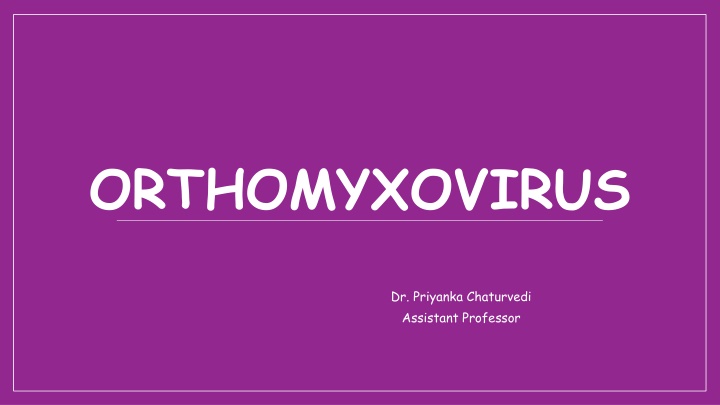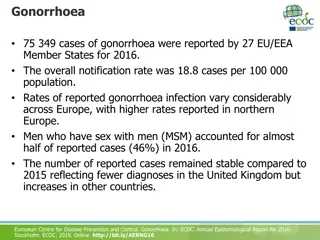
Orthomyxovirus: Structure and Function
Explore the intricate world of Orthomyxovirus - a group of viruses that bind to mucin receptors, causing hemagglutination. Learn about the morphology, replication, and proteins of Influenza viruses belonging to the Orthomyxoviridae family.
Download Presentation

Please find below an Image/Link to download the presentation.
The content on the website is provided AS IS for your information and personal use only. It may not be sold, licensed, or shared on other websites without obtaining consent from the author. If you encounter any issues during the download, it is possible that the publisher has removed the file from their server.
You are allowed to download the files provided on this website for personal or commercial use, subject to the condition that they are used lawfully. All files are the property of their respective owners.
The content on the website is provided AS IS for your information and personal use only. It may not be sold, licensed, or shared on other websites without obtaining consent from the author.
E N D
Presentation Transcript
ORTHOMYXOVIRUS Dr. Priyanka Chaturvedi Assistant Professor
INTRODUCTION Group of viruses that bind to mucin receptors on the surface of RBCs (myxo in Greek meaning mucin ). Mucin receptors causes clumping of RBCs together to cause hemagglutination. Myxoviruses are divided into two families (1) Orthomyxoviridae and (2) Paramyxoviridae
INTRODUCTION Orthomyxoviridae: Influenza viruses cause upper respiratory tract infections (URTIs), rarely pneumonia
Morphology Influenza viruses consist of 4 genera- Influenza A, B, C and D Spherical and 80 120 nm in size Helical nucleocapsid, surrounded by an envelope
Morphology Viral RNA comprises of multiple segments of negative sense single stranded RNA. Each segment codes for a specific viral protein having a specific function. Influenza A & B contain eight segments of RNA Influenza C & D contains seven segments of RNA. The segment coding for neuraminidase is absent.
Morphology Site of replication: RNA replication occurs in - nucleus Viral proteins: Contains eight structural proteins (PB1, PB2, PA, NP, HA, NA, M1 and M2) and two non-structural proteins (NS1 and NS2)
Morphology Envelope: Lipid envelope into which two types of glycoproteins are inserted. Hemagglutinin (HA) Neuraminidase (NA)
Morphology Hemagglutinin binds respiratory epithelial cells facilitating viral entry (HA): Triangular-shaped sialic acid peplomer on - to mucin or receptors the Neuraminidase (NA): Mushroom shaped enzyme - degrades the sialic acid receptors on the host cells - facilitates release of virus particles from infected cell surfaces sialidase
Antigenic Subtypes and Nomenclature Based on RNP and M proteins, influenza viruses - divided into four genera: A, B and C and D Subtypes- Based on HA and NA antigens, Influenza A has - subtypes (N1-N11). Influenza B and C viruses - have subtypes - not designated. Influenza D virus - infects cattle and are not pathogenic to humans. 18 H subtypes (H1 to H18) and 11 N
Antigenic Subtypes and Nomenclature Standard nomenclature system: Influenza Type/ host (indicated only for non-human origin)/ geographic origin/strain number/year subtype). of isolation/(HA NA Examples: Human strain- Influenza A/Hong Kong/03/1968(H3N2) Nonhuman strain- Influenza A/swine/Iowa/15/1930(H1N1)
Antigenic Variation Antigenic variation is the unique property of Influenza viruses, which is due to the result of antigenic changes occurring in HA and NA peplomers. Antigenic drift Antigenic shift
Antigenic drift Minor change - due to point mutations in the HA/NA gene. Results in alteration of amino acid sequence of the antigenic sites on HA/NA, such that virus can escape recognition by the host's immune system. New variant must sustain two or more mutations to become epidemiologically significant. Seen in both Influenza virus type-A&B Results in outbreaks and minor periodic epidemics occurs more frequently every 2-3 years. -
Antigenic Shift Abrupt, major drastic, discontinuous variation sequence of a viral surface protein (HA/NA) Due to genetic re-assortment between genomes of two or more influenza viruses infecting the same host cells, resulting in a new virus strain, unrelated antigenically to the predecessor strains. Occurs only in Influenza A virus Pandemics and major epidemics- e.g. H1N1 pandemics of 2009. Occurs less frequently every 10-20 years. in the
Pathogenesis Transmission: (i) inhalation of respiratory droplets, (ii) via contact with surfaces or fomites. Target cell entry: Viral HA attaches to specific sialic acid receptors on the respiratory mucosa viral entry Multiply locally
Pathogenesis Spread: To the lower respiratory tract or spills over bloodstream extrapulmonary sites Local damage: Cellular destruction and desquamation of superficial mucosa of the respiratory tract secondary bacterial infection.
Clinical Manifestations Incubation period - 18-72 hours Uncomplicated Influenza (Flu syndrome): Asymptomatic or minor upper respiratory symptoms - chills, headache, and dry cough, followed by high grade fever, myalgia and anorexia. Self-limiting condition.
Complications Pneumonia: Secondary bacterial pneumonia - most common Common agents are staphylococci, pneumococci and Haemophilus influenzae. Primary Influenza pneumonia - rare - leads to more severe complication.
Complications Other pulmonary complications: Worsening of COPD Exacerbation of chronic bronchitis and asthma.
Epidemiology Incidence: 3 5 million cases of severe illness and 3-6 lakhs of deaths occur worldwide. Seasonality: Common during winters. Epidemiological pattern: Depends upon the nature of antigenic variation that occurs in the influenza types.
Risk Factors Age: Child of age < 2 years or age 65 years Chronic hematologic, metabolic, neurological, and neurodevelopmental disorders diseases: Chronic pulmonary, cardiac, renal, Immunosuppression (including HIV/AIDS, use of long term corticosteroids, post-transplant patients), diabetes mellitus.
Major influenza outbreaks Years 1889 1890 1900 1903 1918 1919 1933 1935 1946 1947 1957 1958 1968 1969 1977 1978b 2009 2010 Subtype H2N8 H3N8 H1N1a (HswN1) (Spanish flu) H1N1a (H0N1) H1N1 H2N2 (Asian flu) H3N2 (Hong Kong flu) H1N1 (Russian flu) H1N1 pdm09 Extent of outbreak Severe pandemic Moderate epidemic Severe pandemic Mild epidemic Mild epidemic Severe pandemic Moderate pandemic Mild pandemic Pandemic
Sialic Acid Receptors Sialic acid receptors - found on the host cell surfaces are specific for HA antigens 2-6 sialic acid receptors: Specific for human influenza strains and are found abundantly on human epithelium but not on lower upper respiratory tract. upper respiratory tract
Sialic Acid Receptors 2-3 sialic acid receptors: Specific for avian influenza strains Found abundantly on bird s intestinal epithelium. In humans, they are present in very few numbers on lower upper respiratory tract.
Sialic Acid Receptors Why pigs are the most common mixing vessels? Both 2-3 & 2-6 sialic acid receptors are found on the respiratory epithelium of pigs and swine flu strains hence, specificity for both the receptor types. Pigs can be infected simultaneously by human, swine and avian strains - mixing vessel. Reassortment - takes place inside the same swine cell.
Avian Flu Birds - primary reservoir All influenza subtypes (18H types and 11N types) found in birds and some of the subtypes - transmitted to mammals. Avian flu strains are highly virulent. They possess PB1F2 protein which targets host mitochondria causing apoptosis.
Avian Flu Infection in Birds Bird flu strains - highly lethal to chickens and turkeys -major cause of economic loss in poultry due to mortality in chickens. Avian flu multiplies in intestinal tracts of birds - shed through feces into water. Influenza viruses do not undergo antigenic variation in birds due to short life span of birds.
Avian Flu Infection in Humans Till date, all human pandemic strains - originated by reassortment between avian and human influenza viruses - mixing has occurred in pigs. A/H5N1 - most common avian flu strain - endemic in the world for the past 15 years. Origin - first reported from Hong Kong in 1997 - spread to various countries including India within few years.
Avian Flu Infection in Humans Less morbidity and more mortality Clinical feature - H5N1 avian flu strains - pneumonia and extra-pulmonary manifestations - diarrhoea and CNS involvement. Other avian flu strains that can cause human infections are- A/H7N7(Netherlands) A/H9N2 ( Hong Kong) A/H7N9 (caused an outbreak in China, 2013)
Laboratory Diagnosis (Avian Flu) Avian flu strains can be identified by real time reverse transcriptase PCR detecting specific HA and NA genes.
Influenza A (H1N1) pdm09 Most California in March 2009. recent pandemic of influenza, emerged in Rapidly spread to the entire world including India over the next few months. WHO declared the pandemic on 11th June 2009.
Epidemiology Origin: reassortment (1 human strain + 2 swine strains + 1 avian strain) and the mixing had occurred in pigs. H1N1 2009 flu originated four by genetic strains of
Epidemiology Transmission: From human to human - rapid spread Less virulent (as it lacks the PB1 F2 protein) More morbidity but less mortality.
Clinical Features Uncomplicated influenza: Mild upper respiratory tract illness and diarrhea Complicated/severe secondary involvement, and multi-organ failure. influenza pneumonia, - high-risk dehydration, groups - bacterial CNS
Laboratory diagnosis of Influenza Specimen: nasopharyngeal swab, kept at 4 C Isolation of virus: Inoculation in embryonated eggs and primary monkey kidney cell lines Growth hemagglutination test. is detected by hemadsorption,
Laboratory diagnosis of Influenza Viral antigens detection by direct IF test Molecular methods: Simultaneously detects - A/H1N1, A/H3N2, Influenza B RT PCR: detects viral RNA Real time-RT PCR: quantifies viral RNA Antibody neutralization test and ELISA. detection by hemagglutination inhibition test,
Real time RT-PCR showing the result (amplification curves) of specimen(s) tested positive for Influenza type Result emission of fluorescence during the cycles is expressed as the A. A/H1N1 B. A/H3N2 C. Type B D. Negative
Treatment of Influenza Specific antiviral therapy - available for influenza virus infection. Start therapy within 48 hours of onset of symptoms for influenza. Neuraminidase inhibitors (zanamivir, oseltamivir, and peramivir)
Treatment of Influenza Matrix protein M2 inhibitor - amantadine and rimantadine - given for some strains of influenza A infection. Strains of A/H1N1 2009 flu and A/H5N1 avian flu and influenza B virus have developed resistance.
General Preventive Measures Strict hand hygiene to be followed. Isolation room: Patients should be kept at isolation room or cohorting to be followed. Containment of coughs and sneezes Respiratory hygiene and cough etiquette Use of gloves and mask for staff and patient
General Preventive Measures Work restriction: CDC recommends - people with influenza-like illness remain at home until at least 24 hours after they are free of fever (100 F) without the use of fever-reducing medications.
Vaccination Prophylaxis Vaccine strains: Based on WHO recommendations, influenza vaccines are prepared every year. Strains to be included - isolated in the previous influenza seasons and strains that are anticipated to circulate in the upcoming season.
Vaccination Prophylaxis Formulations: Cocktails containing two type A and one or two type B influenza strains. Trivalent form: This is the most common form available; comprises of three strains: A/H1N1, A/H3N2 and influenza B strain. Quadrivalent form: Comprise of four strains: A/H1N1, A/H3N2 and two lineages of influenza B strain
Vaccination Prophylaxis Composition: The lineages of A/H1N1, A/H3N2 and influenza B strains -change every year. Lineages hemispheres different for northern and southern Types: Both injectable (inactivated) and nasal spray (live attenuated) vaccines are available.
Vaccination Prophylaxis Injectable Vaccines: Most widely used vaccines in immunization programmes. Types: There are three types of injectable vaccines. Inactivated Influenza Vaccine (IIV) Cell Culture-based Inactivated Influenza Vaccine (ccIIV3) Recombinant Influenza Vaccine (RIV)
Vaccination Prophylaxis Schedule: Single dose - intramuscular (IM) route; except for 6 month-8 year of age (2 doses are required 4 weeks apart). Timing of vaccination: Optimally before onset of influenza season, i.e. by end of October. Side effects: Mild reactions can occur in 5% of cases - redness at injection site, fever and aches. Serious side effects - rare.







